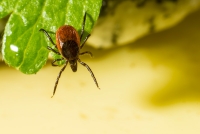The Benefits of Micronutrients In Lyme Disease
Lyme disease, also called Borreliosis, is a tick born bacterial infection and is the most common vector born disease in the United States and Europe. It is caused by the bacterium of the Borrelia species which is carried by the ticks from animals to humans. Due to unspecific flu-like symptoms including headache, fatigue, low grade fever, rash and joint pains, it is hard to diagnose and treat Lyme disease at an early stage. If the bacteria is not eliminated more symptoms develop that can last for months or years and significantly reduce an individual’s quality of life. Various antibiotics are not fully effective especially against latent forms of the bacteria and also add the risk of side effects.
Borrelia sp. exists in three morphological forms which allow them to withstand and survive changing and even hostile environments. These are the active forms called spirochetes, and the latent forms called rounded forms and biofilm. The symptoms of Lyme disease indicate an inflammatory response of the body to the infection. The scientists at the Dr. Rath Research Institute evaluated various natural compounds against Borrelia at the cellular level. Our scientists tested 45 natural compounds against all morphological forms of two species of Borrelia: Borrelia burgdorferi sensu stricto (the pathogen causing Lyme disease in the US) and Borrelia garinii (the pathogen causing Lyme disease in Europe).1 Our study results have shown that all tested compounds inhibited bacterial growth of active spirochetes. In the case of the more resistant, latent forms of Borrelia, the most effective substances that could eliminate these forms were cis-2-decenoic acid, rosmarinic acid, baicalein, monolaurin, luteolin, and kelp (iodine). It is encouraging that the biofilm-like colonies formed by Borrelia burgdorferi, which are the most difficult to treat, were reduced by baicalein, luteolin, monolaurin, cis-2-decenoic acid, and kelp (iodine). In addition, baicalein and monolaurin showed preventive effects by reducing biofilm formation by Borrelia garinii.
In addition, we tested the efficacy of this natural approach both in vivo and in a pilot clinical study.2 We confirmed the efficacy of a combination of baicalein, luteolin, rosmarinic acid, monolaurin, cis-2-decenoic acid, and kelp (iodine) against both forms of Borrelia sp. in vivo. The antibacterial effects of these micronutrients were comparable with the effectiveness of standard antibiotic treatment protocol for Lyme disease. Moreover, they also showed antioxidant and anti-inflammatory benefits. This combination was further tested in a pilot clinical study in Lyme disease patients who had previously taken several rounds of antibiotics without any improvement. After six months of taking the combination of natural compounds, 65% of the participants noted significant improvement in their symptoms and were able to start working and resume their normal daily activities. Seventeen percent of the participants noted moderate symptomatic improvements with regard to energy levels and overall feeling of wellbeing.
The current statistics indicate that approximately 35,000 Americans are diagnosed with Lyme disease every year. However, the CDC also specifies that this number is vastly under represented and the actual case count could be as high as 476,000 per year in the United States. The standard antibiotic treatment might be able to reduce the bacterial load when applied early, but it does not help with improvement of symptoms, especially in more advanced stages of Lyme disease. Therefore, safe natural compounds that can control several biological mechanisms associated with this infection, and can display comparable scientific efficacy to antibiotic treatments may provide an encouraging alternative.
Ref:
1. A Goc, et al., Journal of Applied Microbiology 2015, 119: 1561-1572
2. A. Goc, et al., Therapeutic Adv in Chronic Disease 2020, 11:1-13
